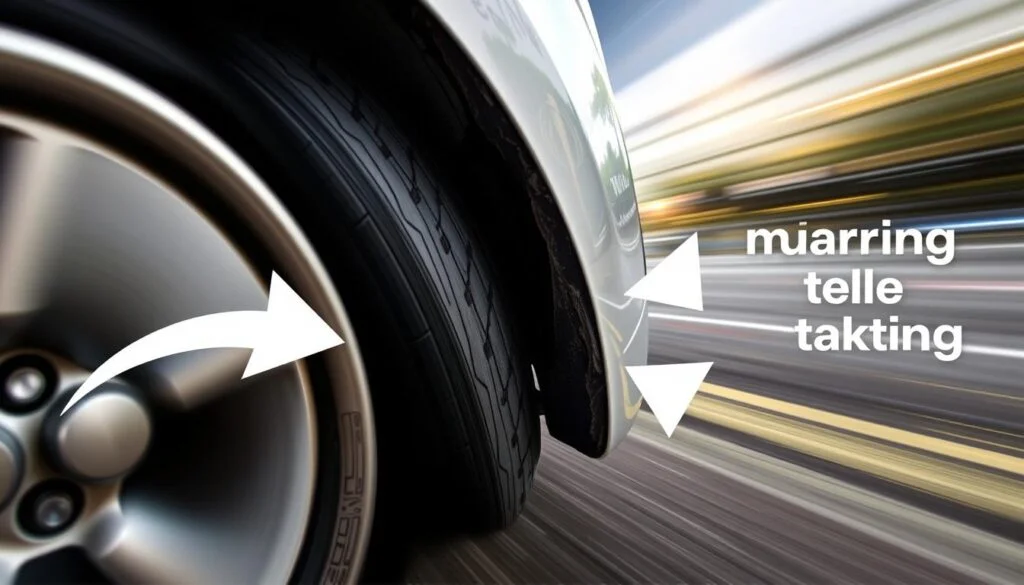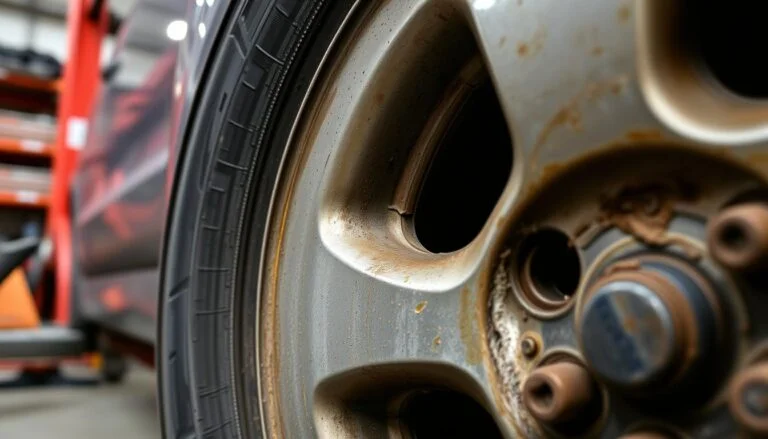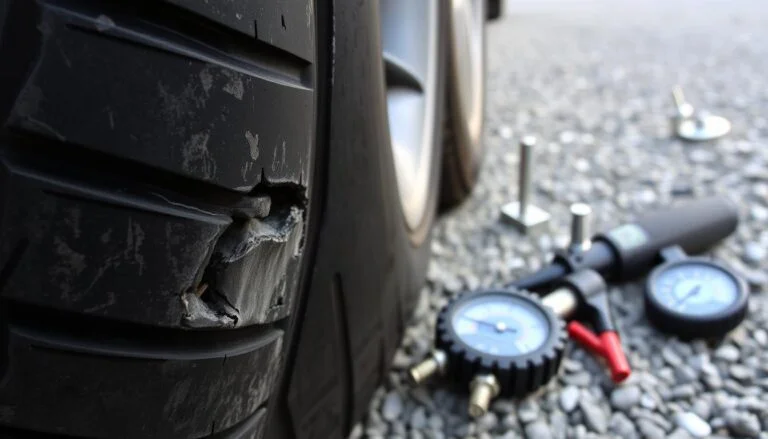What is the impact of a bent wheel on vehicle handling?
Keeping your vehicle’s handling and stability is key for safe and fun driving. But, a small problem like a bent wheel can really affect how your car performs. It’s important to know how a bent wheel impacts your car’s safety and how it handles.

Key Takeaways
- Bent wheels can severely impact vehicle handling and stability.
- A bent wheel can cause uneven tire wear, suspension stress, and alignment issues.
- Immediate effects include reduced steering response, decreased cornering ability, and potential loss of control.
- Long-term effects may include accelerated tire wear, decreased fuel efficiency, and interference with electronic safety systems.
- Prompt identification and professional repair are essential to restore the vehicle’s handling and safety.
Understanding Bent Wheels: Causes and Identification
Keeping your wheels aligned is key for your car’s smooth ride and long life. Bent wheels can mess with your car’s handling, fuel use, and safety. Knowing why and how to spot wheel damage is the first step to fix it.
Common Causes of Wheel Damage
Collisions with potholes, curbs, or other road hazards often bend wheels. These impacts can warp the wheel’s shape, causing problems. Also, regular wear and tear can damage wheels, especially if your car goes over rough terrain or carries heavy loads.
Visual Signs of a Bent Wheel
- Uneven tire wear patterns, with one side of the tire wearing down faster than the other
- Vibrations or shaking in the steering wheel, especially at higher speeds
- Pulling or drifting of the vehicle to one side while driving on a flat road
- Visible deformations or cracks in the wheel’s structure
Professional Inspection Methods
For a detailed check of wheel damage, get a pro’s help. A automotive maintenance expert can use special tools and computer diagnostics. They’ll find any wheel problems and suggest fixes.
| Inspection Method | Purpose |
|---|---|
| Wheel Alignment Check | Determines if the wheels are properly aligned and detects any irregularities in the wheel’s positioning |
| Visual Inspection | Examines the wheel’s physical structure for any visible signs of damage, such as cracks or deformations |
| Computerized Diagnostics | Utilizes advanced technology to precisely measure and analyze the wheel’s condition, providing a comprehensive assessment |
By knowing why and how to spot bent wheels, you can fix this issue early. This keeps your wheel alignment in check, ensuring a safe and smooth drive.
Immediate Effects on Vehicle Performance and Safety
A bent wheel can greatly affect a vehicle’s performance and safety. It can change how the vehicle handles and steers. This can make driving much less safe.
A bent wheel can mess up the brakes. It can cause the brake pads to wear unevenly. This makes stopping the car harder and longer.
It also affects how the car accelerates. The bent wheel can make the car pull to one side when speeding up. This is hard to control, especially when trying to merge onto highways or make sharp turns.
- Uneven tire wear and premature tread loss due to the wheel misalignment
- Increased vibrations and noise, which can be distracting and fatiguing for the driver
- Potential damage to other suspension and steering components, leading to further issues
| Performance Metric | Impact of Bent Wheel |
|---|---|
| Braking Effectiveness | Reduced, leading to longer stopping distances |
| Acceleration Stability | Decreased, causing the vehicle to pull or veer |
| Steering Responsiveness | Diminished, making the vehicle more difficult to control |
In conclusion, a bent wheel can have serious effects on a vehicle’s performance and safety. It can mess up braking, acceleration, and steering. Fixing this problem quickly is key to keeping the car safe and reliable.
What is the impact of a bent wheel on vehicle handling?
Bent wheels can greatly affect how a vehicle handles. They can make driving harder in the short and long term. Knowing these effects is key to keeping vehicles safe and running well.
Short-term Handling Changes
A bent wheel can change how a vehicle handles right away. The vehicle stability and cornering performance might get worse. This makes it harder to control the vehicle, especially at high speeds or sharp turns.
This can raise the chance of accidents. It also makes driving more difficult for the driver.
Long-term Vehicle Behavior
Over time, a bent wheel can make a vehicle’s handling and automotive safety worse. The tire wears unevenly, and the suspension system’s alignment changes. This leads to unpredictable and unstable driving.
It can cause the vehicle to pull or drift when driving straight. This makes it hard to stay in the right lane.
Safety Implications
The effects of a bent wheel on handling are serious for automotive safety. The vehicle’s stability and control drop. This raises the risk of losing control, especially in emergencies or on tough roads.
This can lead to more accidents. It puts the driver, passengers, and others on the road at risk.
| Handling Characteristic | Impact of Bent Wheel |
|---|---|
| Vehicle Stability | Decreased stability, increased risk of loss of control |
| Cornering Performance | Reduced ability to maintain desired trajectory during turns |
| Straight-line Driving | Uneven tire wear, alignment issues leading to pulling or drifting |
| Overall Safety | Increased risk of accidents, particularly in emergency situations |
Drivers and car experts can take steps to fix a bent wheel. This keeps driving safe, reliable, and fun.
Impact on Tire Wear Patterns and Longevity
A bent wheel affects more than just the wheel itself. It also impacts the tires, causing uneven wear. This can lead to tires needing to be replaced sooner and lasting less long.
Wheels need to be aligned properly for even tire wear. A bent wheel disrupts this alignment. This makes the tire wear down unevenly, especially on one side.
| Tire Wear Pattern | Cause | Impact |
|---|---|---|
| Feathering | Bent wheel or misalignment | Uneven tread wear, reduced tire life |
| Center Wear | Over-inflation | Increased fuel consumption, poor handling |
| Shoulder Wear | Under-inflation | Decreased traction, reduced tire life |
A bent wheel also shortens tire life. The tire wears down faster due to the misalignment. This means you’ll need to replace tires more often, increasing maintenance costs.
It’s important to regularly check tire rotation and wheel alignment. Fixing bent wheels quickly helps your tires last longer. This keeps your vehicle running safely and efficiently.
Relationship Between Bent Wheels and Suspension Systems
When a wheel becomes bent, it affects the vehicle’s suspension system a lot. The suspension parts, which help for a smooth ride and control, face more stress. This is because the bent wheel misaligns things.
Stress on Suspension Components
A bent wheel changes the wheel’s alignment. This leads to uneven weight and more stress on parts like control arms, ball joints, and shocks. This stress can make these parts wear out faster, affecting the suspension’s performance.
Alignment Issues and Solutions
A bent wheel messes with the vehicle’s suspension alignment. This affects how the wheels sit relative to the car’s body. It can cause uneven tire wear, bad handling, and unsafe driving. To fix this, a professional alignment is needed to get the vehicle stable and controlled again.
Prevention Strategies
- Regularly check wheels for damage or bending
- Be careful on the road, avoiding potholes or curbs
- Replace bent or damaged wheels quickly
- Get regular checks and alignments for the suspension
Knowing how bent wheels affect the suspension helps owners prevent damage. It keeps their vehicle safe and running well for longer.
| Suspension Component | Impact of Bent Wheel |
|---|---|
| Control Arms | Increased stress and accelerated wear |
| Ball Joints | Compromised stability and handling |
| Shocks and Struts | Reduced shock absorption and ride quality |
“Properly maintaining the suspension system is crucial for ensuring a vehicle’s handling, stability, and overall safety.”
Effects on Steering Response and Control
A bent wheel can greatly affect how a vehicle steers and controls. This can make driving more difficult and less safe. Drivers may find it hard to handle their vehicle properly.
One big change is how the steering feels. The wheel might feel too heavy or too light. This makes steering less precise and more unpredictable.
Also, a bent wheel can cause the steering to vibrate. This makes drivers feel less in control, especially at high speeds. Even small turns can lead to losing control of the vehicle.
| Steering Characteristic | Impact of Bent Wheel |
|---|---|
| Steering Precision | Reduced, leading to imprecise and unpredictable handling |
| Steering Effort | Increased, requiring more strength and effort to turn the wheel |
| Steering Feedback | Diminished, making it harder for the driver to gauge the vehicle’s response |
| Steering Stability | Decreased, resulting in a loss of control and increased risk of accidents |
In bad cases, a bent wheel can make the car veer off course. This is especially true when turning, merging, or staying in one lane. It’s a big problem for safe driving.
It’s very important to check and fix a bent wheel quickly. If not, the steering problems will get worse. This could be dangerous for everyone on the road.

Vehicle Stability Control System Interference
A bent wheel can really mess with a vehicle’s stability control systems. These systems are key to keeping the vehicle safe and stable. But, a bent wheel can throw off their performance.
Electronic Stability Program Reactions
The electronic stability program (ESP) is a vital part of modern vehicles. It keeps the vehicle stable by adjusting brakes and engine power. But, a bent wheel can confuse the ESP, causing it to act strangely.
ABS System Performance
The anti-lock braking system (ABS) stops wheels from locking up during hard braking. This helps the driver steer better. Yet, a bent wheel can mess with the ABS sensors, making the system fail to work right.
Traction Control Challenges
Traction control systems help the vehicle stay on the road, even when it’s slippery. A bent wheel can trick the system, leading to wrong power adjustments. This can even shut down the system, making it hard to handle tough situations.
Having a bent wheel can really affect how well a driver can control the vehicle. It’s important to fix this issue to keep the vehicle safe and running well.
| Stability Control System | Impact of Bent Wheel |
|---|---|
| Electronic Stability Program (ESP) | Confuses system, leading to unpredictable responses |
| Anti-Lock Braking System (ABS) | Disrupts sensor data, causing braking effectiveness issues |
| Traction Control | Misinterprets vehicle behavior, compromising grip and control |
Fuel Efficiency and Performance Degradation
When a vehicle’s wheels become bent, it affects its vehicle dynamics and automotive maintenance. This can lead to a drop in fuel efficiency and performance.
Bent wheels increase rolling resistance. This means the engine uses more energy. As a result, the vehicle’s fuel efficiency goes down because the engine works harder.
The vehicle dynamics also suffer. Bent wheels can make the vehicle slow to accelerate and reach lower speeds. This makes the vehicle less responsive and less powerful.
To show the impact, here’s a table comparing a vehicle with and without bent wheels:
| Metric | Vehicle with Straight Wheels | Vehicle with Bent Wheels |
|---|---|---|
| Fuel Efficiency (MPG) | 25 | 22 |
| 0-60 mph Acceleration (seconds) | 8.2 | 9.1 |
| Top Speed (mph) | 115 | 110 |
The table shows bent wheels can lower fuel efficiency and performance. This highlights the need for good vehicle dynamics and automotive maintenance.

“Maintaining the integrity of your vehicle’s wheels is crucial for both fuel efficiency and performance. Ignoring bent wheels can result in significant degradation in these areas.”
Professional Repair Options and Costs
When a wheel gets bent, car experts must decide to repair or replace it. This choice depends on the damage, cost, and service availability.
Repair vs. Replacement Decision
A skilled technician might fix a slightly bent wheel. This can save money, especially for older cars or those on a tight budget. But, for serious damage, replacing the wheel is safer and better for the car.
Cost Considerations
- Repairing a wheel can cost between $50 and $300, based on the damage and repair complexity.
- Replacing a wheel costs $200 to $500 or more, including the new wheel and installation.
- Extra costs for balancing, alignment, and suspension work might be needed to fix the car’s performance.
Finding Qualified Services
Finding a good repair shop is key for a bent wheel. Look for shops with a good repair or replacement history and suspension expertise. Friends or car forums can help find reliable services.
Choosing to repair or replace a bent wheel needs careful thought. It’s about the damage, future car health, and cost. A qualified mechanic can help make sure your car is safe and drives well.
| Repair Option | Cost Range |
|---|---|
| Wheel Repair | $50 – $300 per wheel |
| Wheel Replacement | $200 – $500+ per wheel |
Conclusion
We’ve looked at how a bent wheel affects a car’s handling and safety. We talked about why wheels get bent and how it changes driving. It’s clear that fixing bent wheels quickly is very important.
A bent wheel can make driving harder and riskier. It can also damage other parts of the car. Knowing the signs of a bent wheel helps keep your car safe and running well.
Being careful and fixing bent wheels fast is key. It keeps your car safe and handles better. By taking care of your wheels, you’ll have a safer and smoother drive.
FAQ
What are the common causes of wheel damage that can lead to a bent wheel?
Potholes, curb impacts, and road hazards can bend a wheel. These issues can make the wheel misaligned.
How can I visually identify a bent wheel?
Look for uneven tire wear and a wheel that seems off-center. If the wheel touches the car’s bodywork, it’s bent.
What are the immediate effects of driving with a bent wheel?
Driving with a bent wheel hurts your car’s performance and safety. It makes braking and acceleration worse.
How does a bent wheel affect the handling and stability of a vehicle?
A bent wheel can make your car pull to one side. It also affects long-term stability and cornering. This can be dangerous.
How does a bent wheel impact tire wear patterns and longevity?
A bent wheel causes uneven tire wear. This shortens the tire’s life and can lead to more frequent replacements.
What is the relationship between a bent wheel and the vehicle’s suspension system?
A bent wheel stresses the suspension, causing alignment problems. Keeping the suspension in good shape is key.
How does a bent wheel affect steering response and control?
Driving with a bent wheel changes how the car steers. It makes it harder to control the vehicle.
How can a bent wheel interfere with a vehicle’s stability control systems?
A bent wheel can mess with electronic stability systems. This can reduce their ability to keep the car stable.
What are the impacts of a bent wheel on fuel efficiency and overall vehicle performance?
A bent wheel increases rolling resistance. This lowers fuel efficiency and hurts the car’s performance.
What are the professional repair options and considerations for a bent wheel?
Depending on the damage, a bent wheel might be fixed or replaced. A mechanic should decide and discuss costs.





